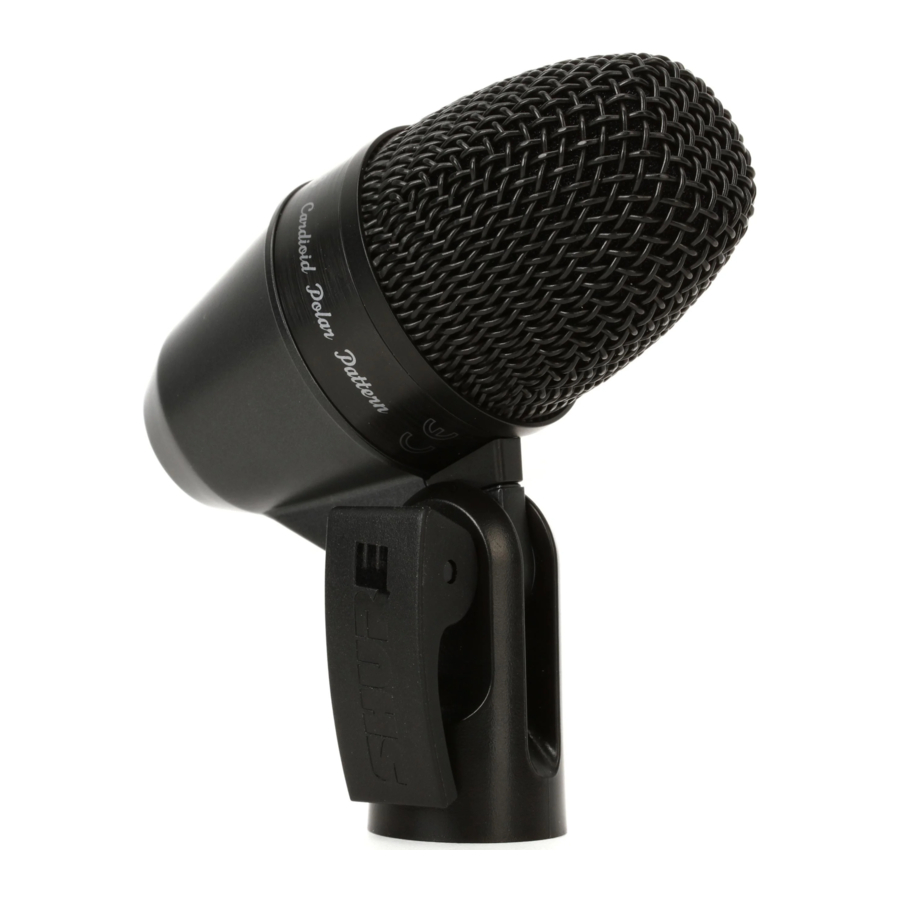
Shure PGA56 - Cardioid Dynamic Snare and Tom Microphone PG Alta Series Manual
- User manual (4 pages) ,
- User manual (4 pages) ,
- User manual (72 pages)
Advertisement

Introduction
Congratulations on the purchase of a new Shure PG Alta series microphone. The PG Alta series delivers professional quality audio at an affordable price, with solutions for capturing nearly any source, including voice, acoustic instruments, drums, and amplified electric instruments. Suitable for live and studio applications, PG Alta microphones are built to last, and meet the same rigorous quality testing standards that make all Shure products trustworthy and reliable.
General Rules for Use
- Do not cover any part of the microphone grille with your hand, as this will adversely affect microphone performance.
- Aim the microphone toward the desired sound source (such as the talker, singer, or instrument) and away from unwanted sources.
- Place the microphone as close as practical to the desired sound source.
- Work close to the microphone for extra bass response.
- Use only one microphone to pick up a single sound source.
- For better gain before feedback, use fewer microphones.
- Keep the distance between microphones at least three times the distance from each microphone to its source ("three to one rule").
- Place microphones as far as possible from reflective surfaces.
- Add a windscreen when using the microphone outdoors.
- Avoid excessive handling to minimize pickup of mechanical noise and vibration.
Proximity Effect
Directional microphones progressively boost bass frequencies as the microphone is placed in closer proximity to the source. This phenomenon, known as proximity effect, can be used to create a warmer, more powerful sound.
Applications And Placement
The following table lists the most common applications and placement techniques. Keep in mind that microphone technique is largely a matter of personal taste; there is no one "correct" microphone position.
| Application | Suggested Microphone Placement | Tone Quality |
| Tom-Toms | One mic on each tom, or between each pair of toms, 2.5 to 7.5 cm (1 to 3 in.) above drum heads. Aim each microphone at top drum heads. On double head toms, you can also remove bottom head and place a mic inside pointing up toward top drum head. | Medium attack; full, balanced sound. |
| Snare Drum | 2.5 to 7.5 cm (1 to 3 in.) above rim of top head of drum. Aim mic at drum head. | Most "snap" from drumstick. |

Avoiding Pickup of Unwanted Sound Sources

Recommended Loudspeaker Locations for Cardioid Microphones
Place the microphone so that unwanted sound sources, such as monitors and loudspeakers, are directly behind it. To minimize feedback and ensure optimum rejection of unwanted sound, always test microphone placement before a performance.
Using the Quick-Release Lever
This microphone features a quick-release lever to easily adjust position.
- Pull the lever open
![]()
- Move the microphone into the desired position
![]()
- Press the lever back towards the microphone to tighten
![]()


Optional Accessories and Replacement Parts
| Microphone Drum Mount | A50D |
| 7.6 m (25 ft.) Cable (XLR-XLR) | C25J |
| Grille | RPMP56G |
| PGA56 Replacement Grille | RPM152 |
Specifications
Type
Dynamic (moving coil)
Frequency Response
50 to 15,000 Hz

Typical Frequency Response
Polar Pattern
Cardioid

Typical Polar Pattern
Output Impedance
200 Ω
Sensitivity
at 1 kHz, open circuit voltage
-57 dBV/Pa 1 (1.45 mV)
--
1 Pa=94 dB SPL
Polarity
Positive pressure on diaphragm produces positive voltage on pin 2 with respect to pin 3
Weight
287 g (10.12oz.)
Connector
Three-pin professional audio (XLR), male
Environmental Conditions
| Operating Temperature | -20° to 165°F (-29° to 74°C) |
| Relative Humidity | 0 to 95% |
Overall Dimensions


Documents / ResourcesDownload manual
Here you can download full pdf version of manual, it may contain additional safety instructions, warranty information, FCC rules, etc.
Download Shure PGA56 - Cardioid Dynamic Snare and Tom Microphone PG Alta Series Manual
Advertisement
Thank you! Your question has been received!























Need Assistance?
Do you have a question about the PGA56 that isn't answered in the manual? Leave your question here.